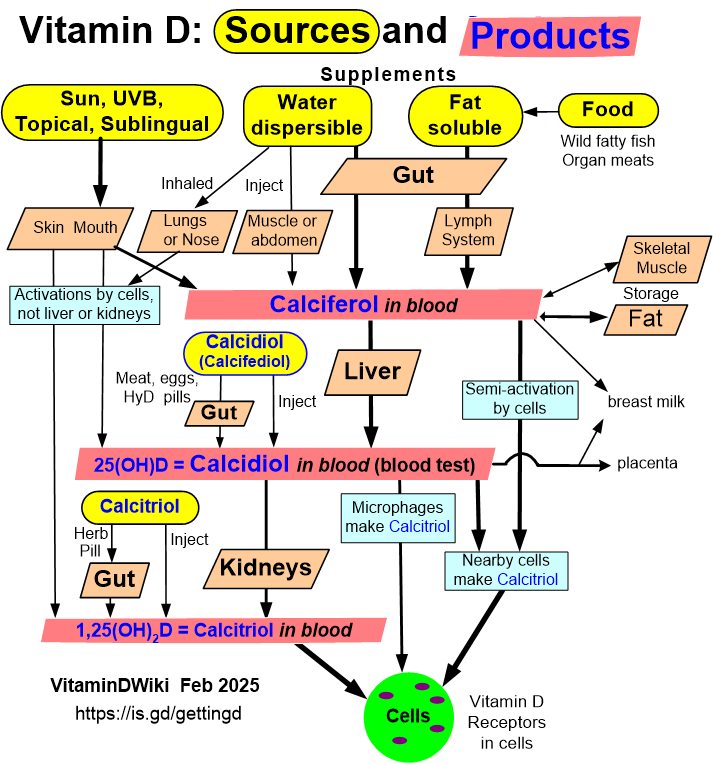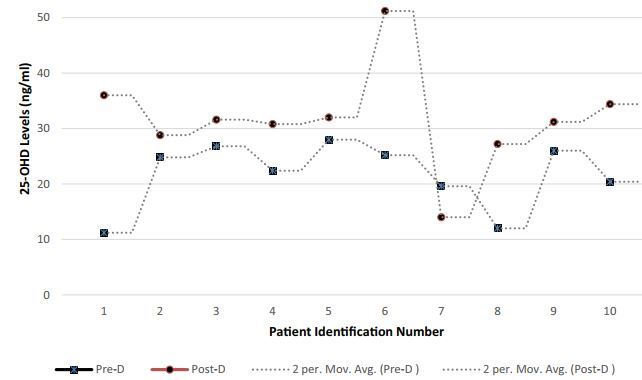Cystic Fibrosis got some benefit from 50,000 IU of vitamin D weekly (need gut-friendly form)
Effect of high dose vitamin D3 therapy on serum vitamin D3 levels in vitamin D insufficient adults with cystic fibrosis
Clinical Nutrition ESPEN, Volume 23, February 2018, Pages 84-88, https://doi.org/10.1016/j.clnesp.2017.12.001
Highlights
High dose oral cholecalciferol repletion in Vitamin D insufficient adults with CF.
Dosing of 10,000 IU from Monday to Friday for a total of 50,000 IU D3 weekly.
Significant increase in serum 25-OHD levels post supplementation.
Supplementation protocol needs to be tested in other CF adult cohorts.
 And the following
{include}
And the following
{include}
📄 Download the PDF from VitaminDWiki
Many had only 10 ng response to 50,000 IU weekly for 12 weeks

Background
The effect of a high dose oral cholecalciferol repletion strategy in Vitamin D insufficient adults with CF is still unknown. Therefore, we assessed the effectiveness of our current approach, giving oral vitamin D3 supplementation at a dose of 10,000 IU from Monday to Friday for a total of 50,000 IU D3 weekly in vitamin D insufficient adult with CF.
Methods
We performed a retrospective chart review of all 59 adult CF patients between the ages of 17 and 64 years routinely followed at the CF Adult Program of Winnipeg Health Sciences Centre. Through consultation with the endocrinologist, our clinic vitamin D repletion protocol for treating CF adult patients who have serum 25-hydroxyvitamin D (25-OHD) < 30 ng/ml (<75 nmol/L) was to prescribe vitamin D3 10,000 IU orally from Monday to Friday (or the weekly equivalent of 50,000 IU) for 12 weeks in addition to their regular CF vitamin that supplied from 800 to 2000 IU vitamin D3 daily. Cholecalciferol was conveniently administered orally as either one capsule (oil-based) 10,000 IU or one tablet (powder-based) 10,000 IU. All patients were instructed to obtain follow-up serum 25-OHD levels post completion of treatment.
Results
Of the 59 adult patients at our CF Clinic, 35 patients (59%) had below optimal serum 25-OHD levels. Of the 35 patients identified, 10 patients with insufficient serum 25-OHD levels between 10 and 30 ng/ml (25–75 nmol/L) fulfilled the inclusion criteria. A significant increase in serum 25-OHD levels was observed (P < 0.01) from mean value of 21.6 ± 5.9 ng/ml (54.1 ± 14.8 nmol/L) at baseline to 31.7 ± 9.1 ng/ml (79.3 ± 22.8 nmol/L) ≥ 2 months post intervention. The current treatment approach was successful in treating Vitamin D insufficiency in 70% of the patients with low 25-OHD levels.
Conclusion
The results of this study demonstrate that a large number of adults attending Winnipeg Health Sciences Centre CF Clinic have serum 25-OHD levels below 30 ng/ml (75 nmol/L). This supports the need for dedicated and individualized approach to manage this condition. High dose therapy of vitamin D3, although a more aggressive treatment approach, may result in achieving optimal levels of serum 25-OHD in adults with CF.
